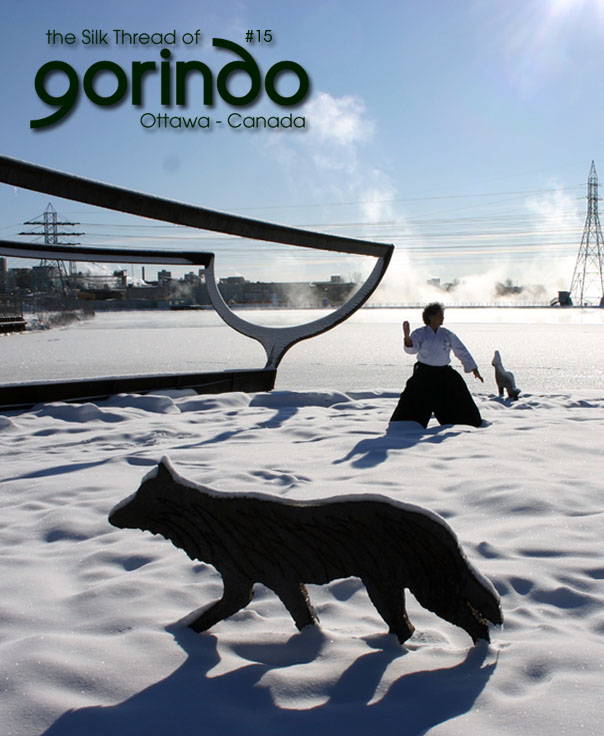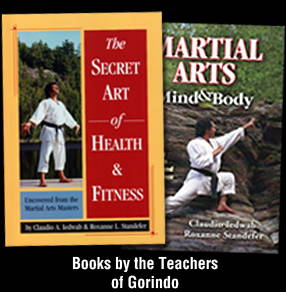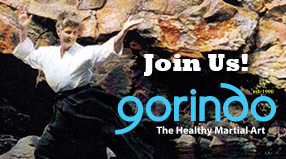The Silk Thread of Gorindo - Ottawa - Canada
Issue 15
Photo cover "Claudio Iedwab at -20°C - Ottawa River" by Roxanne Standefer sensei, 29th December 2011.The Sculpture owned by the NCC is called Boat Sight by John McEwen (1984).
The boat (representing culture) comes in to shore and the wolves (representing Nature) are curious and cautious. The location is the voyageur portage around the Chaudiére Falls in Hull, Quebec.
The Dojo

Once you have made up your mind to study under a certain sensei, do not use your immature martial spirit to criticize him or her. Study enthusiastically so that it will seem as if you have assumed the sensei’s habits, but don’t attempt to copy him or her, be yourself, that is also one of the reasons why sensei is accepting you as a student.
Approach your Martial Art studies with a beginner’s mind, and you will be most open to learn and maintain interest in the activity. There is a very important concept in the Martial Arts known as nyuanshin (yielding heart, receptive mind) which means a quality of humbleness and a certain flexibility of spirit, free of ego and pride, that attests to one’s readiness to accept the teachings of their chosen sensei as they are presented. (Morisawa; The Secret of the Target, 1984). This does not mean that you must follow blindly nor that questions cannot be asked. However, it is in the nature of the training that knowledge can sometimes only be revealed gradually like peeling the layers of an onion.
You must have trust in your teacher and the willingness to suspend your disbelief for a time, so that you can acquire the basic underpinnings of understanding. You have chosen your sensei because of his experience and wide ranging knowledge. Take advantage of this, and do not question his or her methods just because you read something in a magazine or “a friend told me... ”. You will make your judgements, but wait until you know something before challenging those with more experience.
It is also true that the teacher must learn to trust the student before certain teachings can take place, for martial techniques must be learned with a moral code to guide their use. Time, experience and continued practice will allow for greater dialogue between the senior student and the sensei. Often however, this exchange becomes less verbal as the student progresses and the learning becomes mutual in advanced training.
There is an old story that tells of an extremely wise person who once met a zen master. Immediately, he began to ask him all sorts of questions. The zen master sat with him and poured him some tea. He continued pouring until the cup was full, and then poured more so that the cup overflowed. Surprised, the wise man observed; “Master, can you not see that the cup is overflowing?” “Well”, said the master, “how do you expect me to teach you anything when your mind is like this cup? You came with your mind too full of things, not to learn but to question, criticize and argue. So I have nothing to say to you, I can teach you nothing. You must empty your cup to make room for knowledge and awareness.”
“Dojo nomino budo to omou na”: Do not think budo is only in the dojo - (Gichin Funakoshi, father of modern karate, 1869-1957). The real purpose of martial art practice is to polish the mind and body, towards the perfection of character. It is practiced not only in the dojo but also in daily life. The budoka’s behaviour is always the same in and outside the dojo, with moderation and no extremes, making him/her capable adapting to any circumstance. Your effort and potential will be wasted if you just go to the dojo, put on the gi, train, finish, change into your street clothes and that’s it.
A final thought to ponder: “Hobo kore dojo”: your life is your dojo.
by Claudio Iedwab & Roxanne Standefer
Originallly published in the Gorindo Student Manual by Claudio Iedwab & Roxanne Standefer
©2011 Photo by Roxanne Standefer
« Click the Subscribe link on the left





